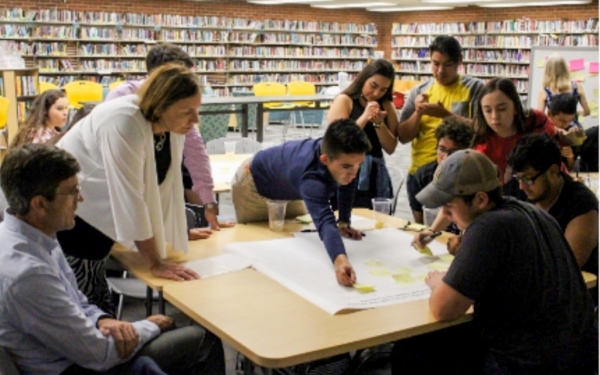A New College Model? Design it with Students.
Local high school students in Tucson, Arizona, participate in the early stages of program design for the new Catholic University model.
When I got a phone call from the Provost of Catholic University three years ago, I did not know why he wanted to meet. But that meeting led to a design sprint, which led to a groundbreaking pilot that launches this fall, COVID notwithstanding. Catholic University wanted to return to an original mission in its 130-year history, to serve those who could not afford its private college sticker price and not only those who could travel to Washington, DC, to live on its storied campus. They were the first university to ask the Lab to help them create a much more affordable version of themselves, and one designed with first-generation Latinx students in parts of the US that have no Catholic colleges. As Provost Andrew Abela, who is now Dean of the Business School, describes it, “We wanted a program that was low-cost and high tech, but also high touch.”
Our task was to co-craft a four-year degree that might cost a student less than $10,000 a year and where they could either live at home or near home. From a pool of 15 cities, our target for the pilot quickly became Tucson, Arizona, a region with significant poverty but on the cusp of significant economic growth, and therefore it wielded a hungry business community. The Mayor and the Bishop were on board and saw this as an opportunity to mitigate the brain drain of Catholic talent as the best and the brightest went away to school, or worse, were coming back not completing their degrees.
Our design process began and ended with students (and, in this community, included parents, who are key decision-makers). Human-centered design requires you to build design criteria before you draft concepts. What value proposition would convince families to test an untested model? To get to parents, we started with the parish priests, to get to students, we approached the high schools. We held several design sessions and conducted surveys with potential students to land on key components of the offering. Some surprises: Parents put cost and career preparation ahead of faith formation and students rated tutoring, career coaching and internships as well as in-person cohorts the highest. Says Abela, ”After much research, we settled on a ‘hybrid learning model.’ This combines small, local cohorts, in-person co-instructors and support staff, cutting-edge online content and testing, a partnership with Pima Community College, and hands-on experience with local employers.”
*** Author: Education Design Lab
*** Source: https://eddesignlab.org/2020/07/newcollegemodel/
*** Source of Pics: Education Design Lab


